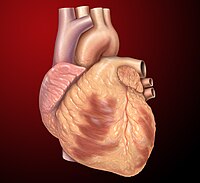
Photo from wikipedia
Background Pediatric inflammatory multisystem syndrome temporally associated with SARS‐CoV‐2 (PIMS‐TS) is an inflammatory disease occurring in a small minority of children a few weeks after acute infection. Cardiac manifestations are… Click to show full abstract
Background Pediatric inflammatory multisystem syndrome temporally associated with SARS‐CoV‐2 (PIMS‐TS) is an inflammatory disease occurring in a small minority of children a few weeks after acute infection. Cardiac manifestations are common, but little is known about the potentially persistent heart changes after PIMS‐TS. Purpose To analyze the frequency and type of myocardial complications of PIMS‐TS with initial cardiac involvement assessed with cardiac magnetic resonance imaging (MRI), including parametric imaging, performed 3 months after hospitalization. Study Type Retrospective. Population Nineteen consecutive children (median age 10 years, interquartile range (IQR) 10–15 years, 74% male). Field Strength/Sequence Balanced steady state free precession (bSSFP, cine imaging), modified Look‐Locker (T1 mapping), T2‐prepared bSSFP (T2‐mapping), dark‐blood T2‐weighted turbo spin echo with fat suppression and phase sensitive inversion recovery (late gadolinium enhancement (LGE)) sequences at 1.5 T. Assessment Patients were scanned after a median of 99 days (IQR 89–104 days) from the diagnosis. MR data were reviewed by three independent observers, with 13, 2, and 5 years' experience in cardiac MRI. Pre‐ and post‐contrast T1, T2, extra‐cellular volume, and T2 signal intensity (T2 SI) ratio were calculated. Diagnosis of acute myocarditis was based on modified Lake Louise criteria. Cardiac MRI parameters were compared, where possible, to previously published pediatric normal values. Statistical Tests Interclass correlation coefficient and Bland–Altman repeatability analysis. A P‐value <0.05 was considered statistically significant. Results Despite cardiac involvement including decreased left ventricular ejection fraction (LVEF) (median LVEF = 47%, IQR 43%–53%) and increased troponin I (median 101 ng/mL, IQR 50–661 ng/mL) during hospitalization, there were no persistent cardiac changes observed in cardiac MR at follow‐up. All patients had normal size and function of the left ventricle and normal precontrast T1 and T2 relaxation times. There were no signs of LGE. Persistent, mild pericardial effusion (8–9 mm) was found in three (16%) patients. Data Conclusion There were no persistent changes on cardiac MRI in a group of children approximately 3 months post hospitalization due to PIMS‐TS with cardiac involvement. This supports the hypothesis that cardiac involvement during PIMS‐TS is a form of transient inflammatory response rather than direct and potentially persistent injury from the virus. Level of Evidence 4 Technical Efficacy Stage 3
Journal Title: Journal of Magnetic Resonance Imaging
Year Published: 2021
Link to full text (if available)
Share on Social Media: Sign Up to like & get
recommendations!